Selecting the perfect BBQ rib type (baby back, St. Louis-style, or spare ribs) is key to an exceptional recipe. Aging techniques enhance flavor and tenderness. The ideal texture achieved through marinating, seasoning with a custom dry rub, and slow roasting at 225°F. A balanced glaze complements natural juices, creating a memorable dining experience for any BBQ enthusiast.
Unleash your inner barbecue master with the ultimate guide to crafting fall-off-the-bone ribs with a savory glaze. This comprehensive journey delves into every aspect of the perfect rib experience, from choosing the right cut – be it baby back, spareribs, or St. Louis style – to mastering dry rubs, spice blends, and glazes that will tantalize your taste buds. Learn the art of slow cooking and smoking for tender, flavorful ribs, then finish them off with a crispy broil for an unforgettable, caramelized glaze. Discover side dishes, drink pairings, and storage tips to complete your BBQ rib masterpiece.
- Choosing the Right Ribs for Your BBQ
- – Types of ribs: Baby back, spareribs, St. Louis style, etc.
- – Selecting quality cuts and preparation methods.
- Marinating and Seasoning Tips
- – Dry rub recipes and techniques.
- – Importance of a good foundation taste.
- – Choosing the right spices for your glaze.
Choosing the Right Ribs for Your BBQ
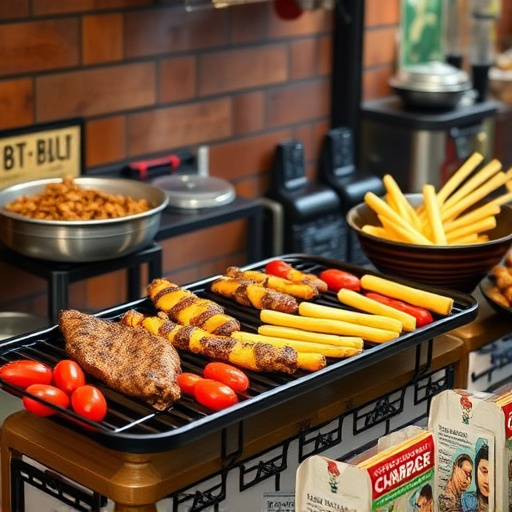
When it comes to crafting the perfect BBQ rib recipe, selecting the right ribs is half the battle won. The most common types are baby back and spare ribs, each with its own unique characteristics. Baby back ribs, as the name suggests, come from the top section of the pig’s spine, offering a smaller, more delicate bone structure and less fat. They’re known for their tender texture and sweet marination, making them a favorite among BBQ enthusiasts. On the other hand, spare ribs, or St. Louis-style ribs, are removed from the belly of the pig, resulting in a larger, meaty chunk with more bones and a slightly stronger flavor.
For ultimate tenderness and flavor infusion, look for ribs that have been dry-aged or wet-aged. Dry-aging involves removing the ribs from the animal and allowing them to age naturally over time, enhancing their natural flavors. Wet-aging, or soaking the ribs in a brine solution, moisturizes them and tenderizes the meat. These techniques ensure that your BBQ rib recipe delivers on both taste and texture, leaving your taste buds craving for more.
– Types of ribs: Baby back, spareribs, St. Louis style, etc.
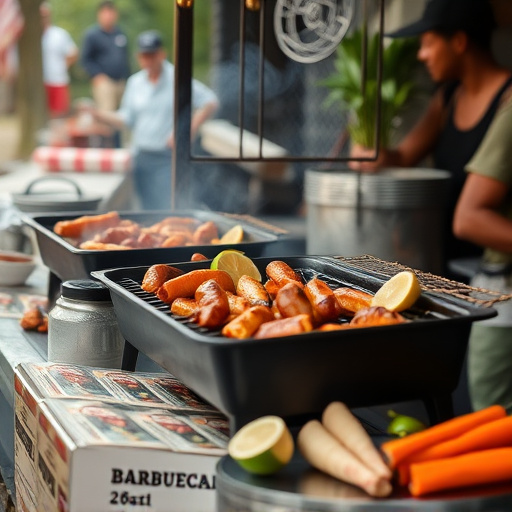
When it comes to BBQ rib recipes, there are several styles and cuts that offer unique flavors and textures. The most common types include baby back ribs, known for their meaty portions and tender bones, perfect for slow-cooking until they literally fall off the bone. Spareribs, on the other hand, are a larger cut with more cartilage, providing a challenging but rewarding cooking experience. St. Louis style ribs, distinctively shaped and seasoned, have gained popularity for their crisp, caramelized exterior and succulent interior. Each variety offers its own take on the classic BBQ rib dish, catering to diverse preferences in terms of flavor profiles and cooking techniques.
For ultimate tenderness, baby back ribs often top the list due to their shorter bone structure and abundant marbling. Spareribs, while requiring more attention, result in a hearty meal with a distinct taste. St. Louis style ribs showcase a beautiful interplay between smoky flavors and tender meat, making them a favorite among BBQ enthusiasts. Choosing the right type of rib is essential for crafting your ideal BBQ rib recipe, whether you prefer them slow-cooked, grilled, or smoked to perfection.
– Selecting quality cuts and preparation methods.
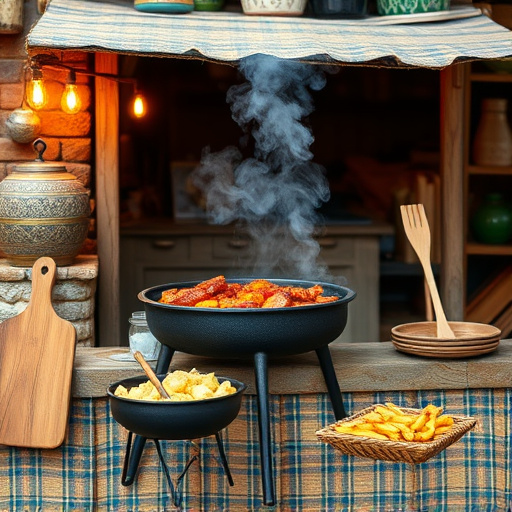
When it comes to crafting the perfect fall-off-the-bone ribs, the journey begins with selecting the right cuts. Opt for quality rib cuts like St. Louis-style or baby back ribs, known for their tender meat and meaty bones. These cuts require careful preparation; start by drying the ribs with paper towels to create a crispy, flavorful crust. Then, apply a generous coating of your favorite bbq rub, allowing the spices to penetrate and enhance the ribs’ natural flavor.
The art of smoking is key to achieving that coveted tender texture. Whether using a traditional charcoal grill or a modern smoker, maintaining a consistent temperature is essential. Aim for a slow cook at around 225°F (107°C), allowing the ribs to gently cook and slowly render their fat, ensuring they become incredibly moist and tender. This method, combined with the savory glaze, will result in ribs that literally fall off the bone, satisfying any bbq enthusiast’s craving.
Marinating and Seasoning Tips
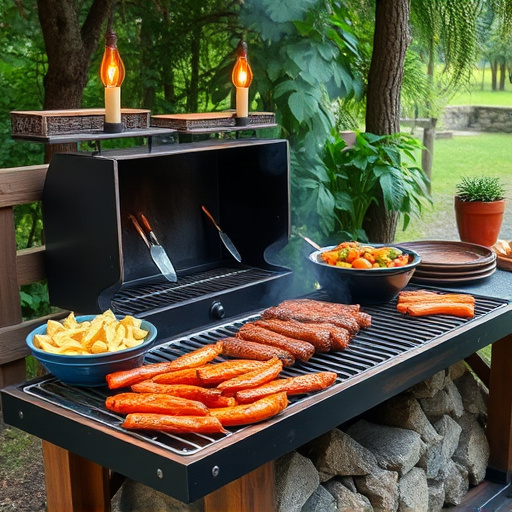
When it comes to achieving that mouthwatering, fall-off-the-bone texture in your BBQ rib recipe, marinating and seasoning are key. Start by soaking your ribs in a mixture of your favorite sauce base – whether it’s ketchup, brown sugar, or a tangy vinegar – along with herbs like garlic, paprika, and black peppercorns. This process not only tenderizes the meat but also infuses it with savory flavors that will make your rib lovers come back for more.
For an extra kick, consider adding spices like chili powder or cayenne pepper to your marinade. Don’t be afraid to experiment with different combinations; the beauty of BBQ rib recipes lies in their customizability. After marinating for a few hours – or even overnight for maximum impact – coat your ribs generously with your preferred dry rub blend before slow-roasting them to perfection.
– Dry rub recipes and techniques.
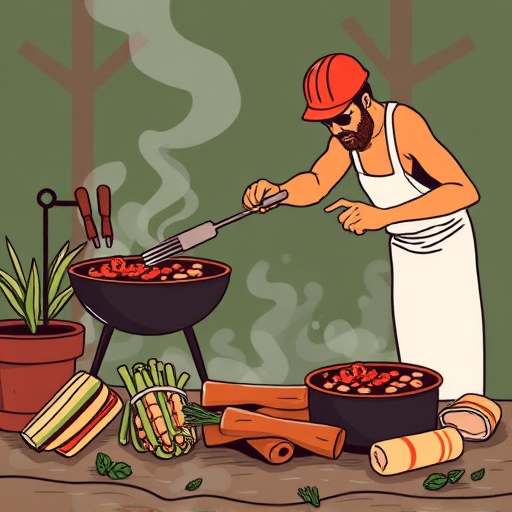
Creating the perfect dry rub for your BBQ rib recipe is an art that can transform a simple dish into a mouthwatering masterpiece. Dry rubs are a beloved technique among barbecue enthusiasts, as they allow for precise control over flavor intensity. The key to a successful dry rub lies in balancing spices—a science that requires both precision and personal preference. Typically, these blends include a combination of salt, pepper, garlic powder, onion powder, chili powder, paprika, and sometimes brown sugar or cayenne pepper. Each ingredient plays a vital role in enhancing the rib’s natural taste without overpowering it.
Application is equally important; massage the rub into the meat to ensure even coverage, allowing the spices to penetrate and infuse for maximum flavor. This process is not just about seasoning but also preparing the ribs for the savory glaze that will follow. The dry rub acts as a foundation, creating a complex and rich taste profile that will leave folks craving more of your BBQ rib recipe.
– Importance of a good foundation taste.
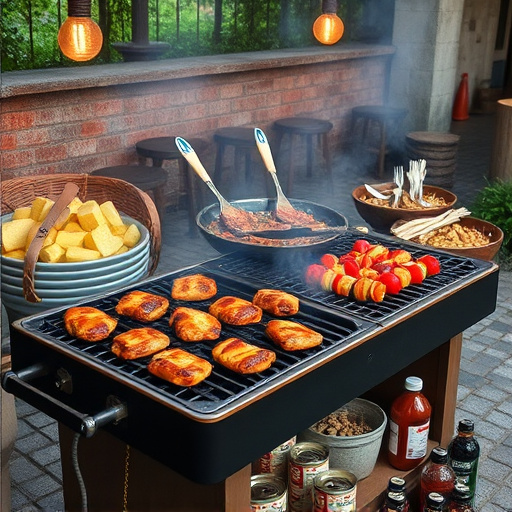
A great BBQ rib recipe starts with a solid foundation of flavor. The initial taste experience sets the stage for the rest of the dining journey, and when it comes to ribs, achieving that perfect balance of sweet, smoky, and savory is essential. This begins with marinating or seasoning the meat thoroughly; a well-crafted rub can transform simple ribs into a mouthwatering delicacy.
The glaze plays an equally vital role in enhancing the overall taste profile. A good glaze should complement the rib’s natural juices without overpowering them. By carefully choosing ingredients that balance acidity, sweetness, and heat, you can create a glaze that glistens and adds an irresistible finish to each tender rib. It’s this harmonious marriage of flavors that makes for truly exceptional BBQ ribs, ensuring every bite is a memorable one.
– Choosing the right spices for your glaze.
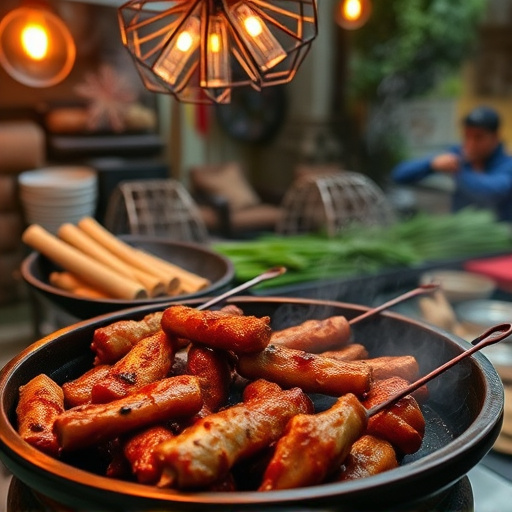
When crafting a savory glaze for fall-off-the-bone ribs, selecting the perfect spices is key. The right blend can transform your BBQ rib recipe from good to exceptional. Consider starting with a base of paprika, garlic powder, and onion powder—these three ingredients form a classic flavor triangle that enhances the natural meat flavors. For added depth, incorporate chili powder or cayenne pepper for a kick, and don’t forget herbs like thyme or rosemary for an aromatic twist.
Adjusting spice levels to your preference is essential. If you love heat, increase the chili powder or add a pinch of red pepper flakes. Conversely, for a milder glaze, reduce the spiciness or omit it altogether. The beauty of homemade glazes lies in their customizability, so feel free to experiment until you find the perfect balance that makes your BBQ rib recipe truly stand out.
